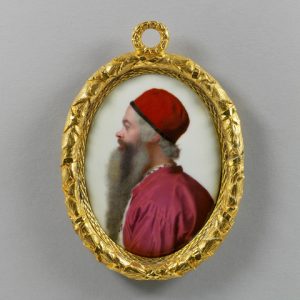Revolutionary War reenacting groups have to decide whether their adult male members must shave off their beards, mustaches, or [most distinguished of all] sideburns for events to make the most accurate visual impression.
Sometimes people try to argue that merely because we don’t see beards in portraits doesn’t mean men never wore them. Beards may have been rare but still common enough not to provoke remarks.
Back in 2012 I wrote a couple of postings about the Boston shoemaker William Scott which refute that argument. For religious reasons he grew his beard long. And his appearance was so unusual he scared children on the street.
Recently I ran across another discussion of a bearded man in the eighteenth-century British Empire at the Walpole 300 site. Jean Etienne Liotard was a portrait painter who spent years in the eastern Mediterranean region. The Lewis Walpole Library explains:
European travelers to the Levant commonly adopted local costumes, including caftans and turbans, but upon returning to Europe, they shaved their beards and shed their oriental dress. (Gullström et al., 187.) Not so Liotard, who had taken a liking to the loose Turkish garments and continued to wear them throughout the rest of his life. In 1743, when the artist arrived in Vienna, he caused an immediate sensation with his oriental robes, large fur hat, and the long beard he had grown according to local custom while in Moldova at the court of prince Constantin Mavrocordato. He attracted the attention of Empress Maria-Theresa and soon received prestigious commissions at the imperial court.The Lewis Walpole Library owns the miniature portrait shown above, which is inscribed “Liotard / by Himself / 1753.” Lady Maria Churchill gave it to Horace Walpole, her older half-brother. And I’m sure we can agree that that’s an impressive beard—especially since no other man in Britain was wearing anything like it.
In 1748, Liotard traveled on to Paris where he exhibited his beard and costume at the opera in order to stimulate interest in his person, and thus to enhance his business as a portraitist. In fact, some of Liotard’s critics claimed that his success depended entirely on his sartorial performance rather than on his talents as a painter. . . .
In 1753, Horace Walpole described Liotard’s arrival in England in a letter to Horace Mann, pointing out the artist’s exotic looks: “From having lived in Constantinople he wears a Turkish habit and a beard down to his girdle: this and his extravagant prices, which he has raised even beyond what he asked at Paris, will probably get him as much money as he covets for he is avaricious beyond imagination.” (Walpole, Correspondence, 20:362.)

No comments:
Post a Comment